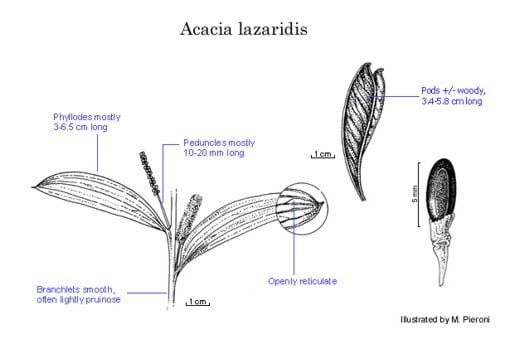Acacia lazaridis Pedley
WATTLE
Acacias of Australia
Family
Fabaceae
Distribution
Occurs in western areas of the Cook and Kennedy Districts, Qld, often on slopes of the Great Dividing Ra.
Description
Shrub 0.5–2.5 m high, glabrous. Branchlets ±flattened, later angular, maroon-brown, grey when older, usually pruinose; ridges prominent. Phyllodes narrowly oblong, elliptic to narrowly ovate-elliptic, often oblique, 3–6.5 (–8) cm long, 11–22 (–27) mm wide, with retuse or rounded apex, coriaceous, stiff, green or subglaucous, with 3 prominent longitudinal main nerves (2 reaching the apex and base, the third confluent with lower margin near base) usually with 4 subprominent parallel nerves (the 2 outer not reaching apex or base); minor nerves 1–2 (–3) per mm, anastomosing; gland 1, basal, sometimes absent. Peduncles (8–) 10–20 mm long. Spikes (0.6–) 1–2 cm long, yellow. Flowers 5-merous; calyx 0.4–0.6 mm long, dissected for 1/4–2/5, glabrous or sometimes fimbriolate; corolla 1.3–1.9 mm long, dissected for 1/2–2/3, glabrous; ovary glabrous. Pods narrowly elliptic or oblanceolate to elliptic, straight-sided, straight to curved, flat, 3.4–5.8 cm long, 7–14 mm wide, often dark purplish- or reddish-brown and slightly pruinose, obliquely nerved, opening and curling back from apex; margins subprominent; seed-partitions thick. Seeds oblique, oblong-elliptic, 4–5 mm long, dark brown; areole open; funicle-aril narrowly conical.
Phenology
Flowers Feb.–Nov.
Habitat
Grows in gravelly red earth or shallow sandy soil, in open eucalypt forest or woodland or scrub with Acacia spp. and Triodia, on sandstone, granite or metamorphic rocks.
Specimens
Qld: 7 miles [11.2 km] NE of Mirtna Stn, L.Adams 1138 (CANB, NSW); Newcastle Ra., between Forsayth and Einasleigh, L.J.Brass 1743 (BRI, MEL, NSW); 12 km N of Charters Towers turnoff, P.Hind 1052 & C.K.Ingram (BRI, CANB, K, MEL, NSW, US); Lappa, A.N.Rodd 4511 & M.Hardie (BRI, NSW, PERTH).
Notes
Acacia lazaridis is very closely related to A. limbata and their relationship needs further study to determine whether or not they should remain as separate species; also allied to A. argyraea.
FOA Reference
Data derived from Flora of Australia Volumes 11A (2001), 11B (2001) and 12 (1998), products of ABRS, ©Commonwealth of Australia
Author
Dr M.D.Tindale and Dr P.G.Kodela with the assistance of M.Bedward, S.J.Davies, C.Herscovitch, D.A.Keith and/or D.A.Morrison
Minor edits by B.R.Maslin & J.Rogers
This identification key and fact sheets are available as a mobile application:
URL: https://apps.lucidcentral.org/wattle/
© Copyright 2018. All rights reserved.








